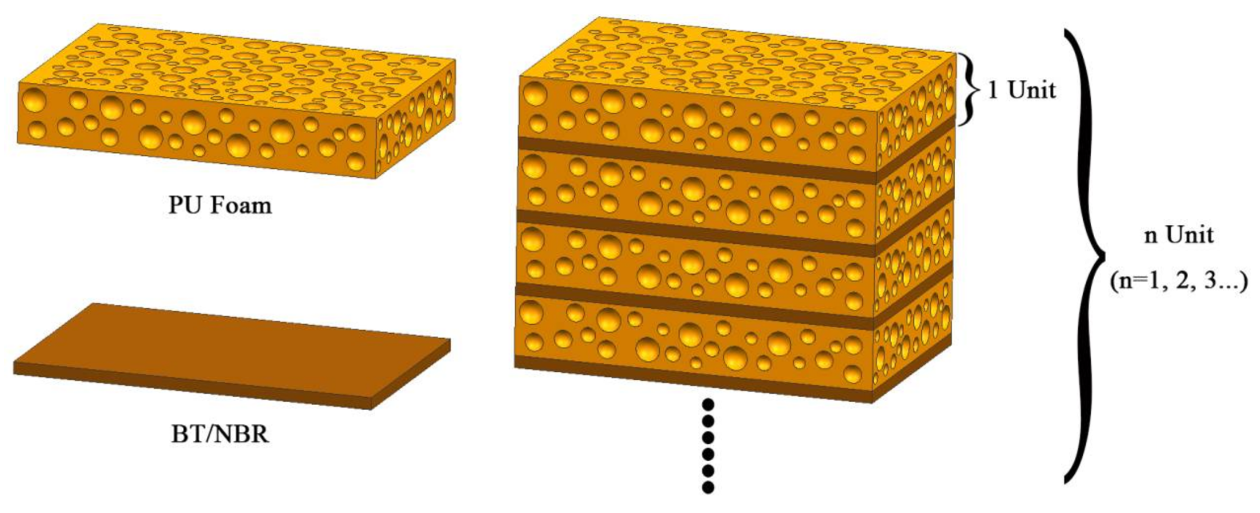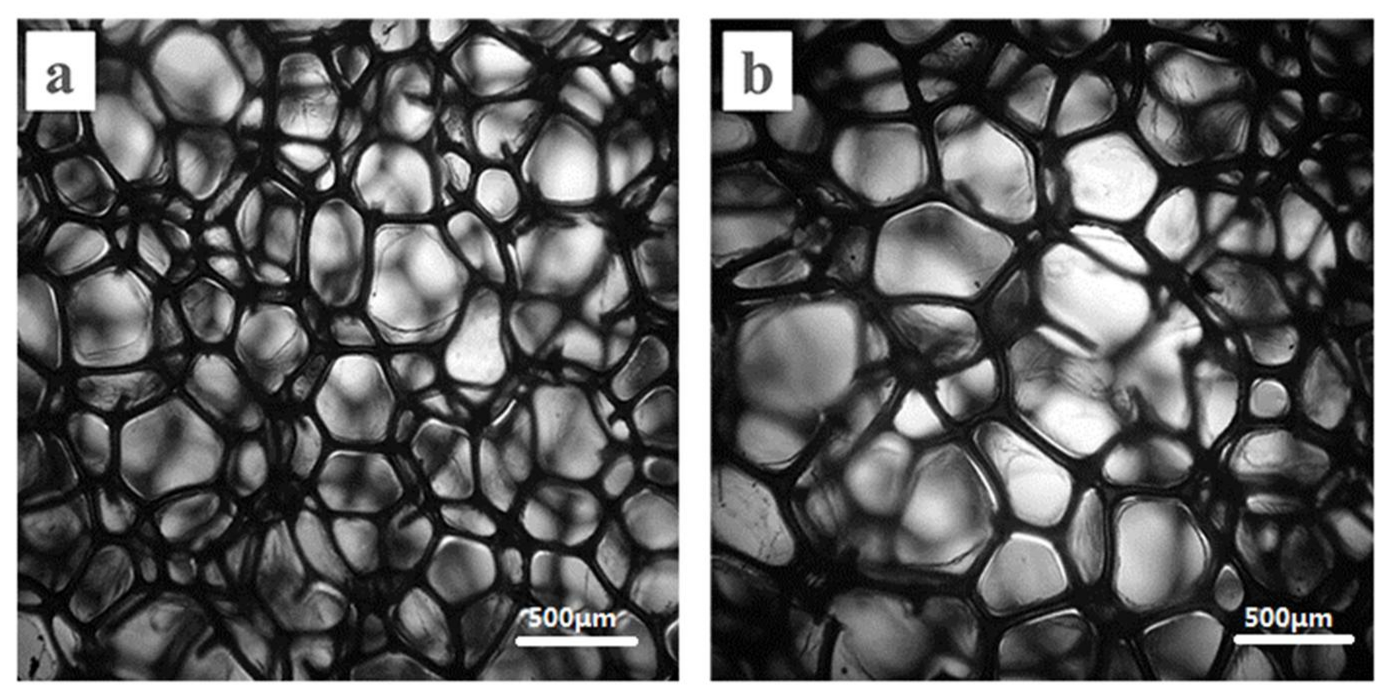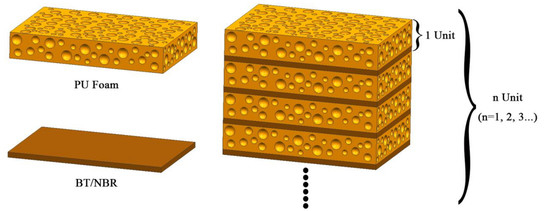Preparation and Sound Absorption Properties of a Barium Titanate/Nitrile Butadiene Rubber–Polyurethane Foam Composite with Multilayered Structure
Abstract
:1. Introduction
2. Materials and Methods
3. Results and Discussion
4. Conclusions
Acknowledgments
Author Contributions
Conflicts of Interest
References
- Yang, M.; Sheng, P. Sound absorption structures: From porous media to acoustic metamaterials. Annu. Rev. Mater. Res. 2017, 47, 83–114. [Google Scholar] [CrossRef]
- Ru, J.M.; Kong, B.; Liu, Y.G.; Wang, X.L.; Fan, T.X.; Zhang, D. Microstructure and sound absorption of porous copper prepared by resin curing and foaming method. Mater. Lett. 2015, 139, 318–321. [Google Scholar] [CrossRef]
- Liu, P.S.; Qing, H.B.; Hou, H.L. Primary investigation on sound absorption performance of highly porous titanium foams. Mater. Des. 2015, 85, 275–281. [Google Scholar] [CrossRef]
- Richoux, O.; Ayrault, C.; Pelat, A.; Félix, S.; Lihoreau, B. Effect of the open roof on low frequency acoustic propagation in street canyons. Appl. Acoust. 2009, 71, 731–738. [Google Scholar] [CrossRef]
- Sousa, A.N.; Gibbs, B.M. Low frequency impact sound transmission in dwellings through homogeneous concrete floors and floating floors. Appl. Acoust. 2011, 72, 177–189. [Google Scholar] [CrossRef]
- Chen, D.; Li, J.; Ren, J. Study on sound absorption property of ramie fiber reinforced poly(l-lactic acid) composites: Morphology and properties. Compos. Part A 2010, 41, 1012–1018. [Google Scholar] [CrossRef]
- Doost-Hoseini, K.; Taghiyari, H.R.; Elyasi, A. Correlation between sound absorption coefficients with physical and mechanical properties of insulation boards made from sugar cane bagasse. Compos. Part B 2014, 58, 10–15. [Google Scholar] [CrossRef]
- Wu, C.M.; Chou, M.H. Polymorphism, piezoelectricity and sound absorption of electrospun PVDF membranes with and without carbon nanotubes. Compos. Sci. Technol. 2016, 127, 127–133. [Google Scholar] [CrossRef]
- Yang, X.H.; Ren, S.W.; Wang, W.B.; Liu, X.; Xin, F.X.; Lu, T.J. A simplistic unit cell model for sound absorption of cellular foams with fully/semi-open cells. Compos. Sci. Technol. 2015, 118, 276–283. [Google Scholar] [CrossRef]
- Maldovan, M. Sound and heat revolutions in phononics. Nature 2013, 503, 209–217. [Google Scholar] [CrossRef] [PubMed]
- Babaee, S.; Viard, N.; Wang, P.; Fang, N.X.; Bertoldi, K. Harnessing deformation to switch on and off the propagation of sound. Adv. Mater. 2016, 28, 1631–1635. [Google Scholar] [CrossRef] [PubMed]
- Xue, B.; Li, R.; Deng, J.G.; Zhang, J.H. Sound absorption properties of microporous poly(vinyl formal) foams prepared by a two-step acetalization method. Ind. Eng. Chem. Res. 2016, 55, 3982–3989. [Google Scholar] [CrossRef]
- Zhai, W.; Yu, X.; Song, X.; Ang, L.Y.L.; Cui, F.; Lee, H.P.; Li, T. Microstructure-based experimental and numerical investigations on the sound absorption property of open-cell metallic foams manufactured by a template replication technique. Mater. Des. 2018, 137, 108–116. [Google Scholar] [CrossRef]
- Zhao, T.B.; Yang, M.T.; Wu, H.; Guo, S.Y.; Sun, X.J. Preparation of a new foam/film structure poly (ethylene-co-octene) foam materials and its sound absorption properties. Mater. Lett. 2015, 139, 275–278. [Google Scholar] [CrossRef]
- Liu, Z.Y.; Zhang, X.X.; Mao, Y.W.; Zhu, Y.Y.; Yang, Z.Y.; Chan, C.T.; Sheng, P. Locally resonant sonic materials. Science 2000, 289, 1734–1736. [Google Scholar] [CrossRef] [PubMed]
- Lu, T.; Pan, H.; Ma, J.; Li, Y.; Bokhari, S.W.; Jiang, X.; Zhu, S.; Zhang, D. Cellulose nanocrystals/polyacrylamide composites of high sensitivity and cycling performance to gauge humidity. ACS Appl. Mater. Interfaces 2017, 9, 18231–18237. [Google Scholar] [CrossRef] [PubMed]
- Jiang, X.; Li, C.; Liu, S.; Zhang, F.; You, F.; Yao, C. The synthesis and characterization of ytterbium-doped TiO2 hollow spheres with enhanced visible-light photocatalytic activity. Rsc. Adv. 2017, 7, 24598–24606. [Google Scholar] [CrossRef]
- Chen, R.; Jiang, X.; You, F.; Yao, C. Optimizing the morphology, mechanical and crystal properties of in-situ polypropylene/polystyrene blends by reactive extrusion. Fibers Polym. 2016, 17, 1550–1557. [Google Scholar] [CrossRef]
- Jiang, X.; Xu, X.; Geng, T.; You, F.; Wang, W.; Yao, C. Fabrication of a novel water swellable styrene-butadiene rubber through the in-situ polymerization of lithium acrylat. Polym. Korea 2016, 40, 684–690. [Google Scholar] [CrossRef]
- Jiang, X.; Zhang, J.; Yu, L.; You, F. Yttria hollow nano-flowers synthesized by hydrothermal method and their adsorption capacity. Chin. J. Inorg. Chem. 2016, 32, 1337–1344. [Google Scholar]
- Jiang, X.; Yu, L.; Yao, C.; You, F.; Zhang, J. Facile fabrication and characterization of ytterbium oxide hollow spheres using carbon spheres as template. Nano 2016, 11, 67–74. [Google Scholar] [CrossRef]
- Jiang, X.; Yu, L.; Yao, C.; Zhang, F.; Zhang, J.; Li, C. Synthesis and characterization of Gd2O3 hollow microspheres using a template-directed method. Materials 2016, 9, 323–333. [Google Scholar] [CrossRef] [PubMed]
- Jiang, X.; Zhang, J.; Yu, L.; Chen, R. Synthesis of mono-dispersed ceria hollow nanospheres by a hydrothermal method. Micro Nano Lett. 2016, 11, 137–141. [Google Scholar] [CrossRef]
- Jiang, X.; Wang, W.; Guan, J.; Yang, H.; Sun, G.; Ren, J. Preparation of CeO2 hollow nanospheres by PMMA template and their low frequency damping capacity. Rare Metal Mater. Eng. 2015, 44, 1249–1253. [Google Scholar]
- Jiang, X.; Du, Y.; Wang, W.; Yang, H.; Ren, J. Preparation of Y2O3 hollow nanospheres by homogeneous precipitation templates method. Rare Metal Mater. Eng. 2014, 43, 249–252. [Google Scholar]
- Jiang, X.; Fan, Y.; Li, F. Preparation and properties of dynamically cured polypropylene (PP)/maleic anhydride–grafted polypropylene (MAH-g-PP)/calcium carbonate (CaCO3)/epoxy composites. J. Thermoplast. Compos. Mater. 2013, 26, 1192–1205. [Google Scholar] [CrossRef]
- Lou, X.; Zhu, C.; Pan, H.; Ma, J.; Zhu, S.; Zhang, D.; Jiang, X. Cost-Effective Three-Dimensional Graphene/Ag Aerogel Composite for High-Performance Sensing. Electrochim. Acta 2016, 205, 70–76. [Google Scholar] [CrossRef]
- Jiang, X.; Fan, Y. Effect of the compatibilizer on the morphology and properties of dynamically cured PP/POE/epoxy blends. J. Appl. Polym. Sci. 2012, 124, 2423–2429. [Google Scholar] [CrossRef]
- Sun, Y.; Fang, Z.; Wang, C.; Zhou, A.; Duan, H. Incorporating nanoporous polyaniline into layer-by-layer ionic liquid-carbon nanotube-graphene paper: Towards freestanding flexible electrodes with improved supercapacitive performance. Nanotechnology 2015, 26, 374002. [Google Scholar] [CrossRef] [PubMed]
- Berardi, U.; Iannace, G. Predicting the sound absorption of natural materials: Best-fit inverse laws for the acoustic impedance and the propagation constant. Appl. Acoust. 2017, 115, 131–138. [Google Scholar] [CrossRef]
- Ning, J.F.; Zhao, G.P. Sound absorption characteristics of multilayer porous metal materials backed with an air gap. J. Vib. Control 2014, 29, 77–89. [Google Scholar]
- Zhu, W.; Nandikolla, V.; George, B. Effect of bulk density on the acoustic performance of thermally bonded nonwovens. J. Eng. Fabrics Fibers 2015, 10, 39–45. [Google Scholar]






© 2018 by the authors. Licensee MDPI, Basel, Switzerland. This article is an open access article distributed under the terms and conditions of the Creative Commons Attribution (CC BY) license (http://creativecommons.org/licenses/by/4.0/).
Share and Cite
Jiang, X.; Yang, Z.; Wang, Z.; Zhang, F.; You, F.; Yao, C. Preparation and Sound Absorption Properties of a Barium Titanate/Nitrile Butadiene Rubber–Polyurethane Foam Composite with Multilayered Structure. Materials 2018, 11, 474. https://doi.org/10.3390/ma11040474
Jiang X, Yang Z, Wang Z, Zhang F, You F, Yao C. Preparation and Sound Absorption Properties of a Barium Titanate/Nitrile Butadiene Rubber–Polyurethane Foam Composite with Multilayered Structure. Materials. 2018; 11(4):474. https://doi.org/10.3390/ma11040474
Chicago/Turabian StyleJiang, Xueliang, Zhen Yang, Zhijie Wang, Fuqing Zhang, Feng You, and Chu Yao. 2018. "Preparation and Sound Absorption Properties of a Barium Titanate/Nitrile Butadiene Rubber–Polyurethane Foam Composite with Multilayered Structure" Materials 11, no. 4: 474. https://doi.org/10.3390/ma11040474





